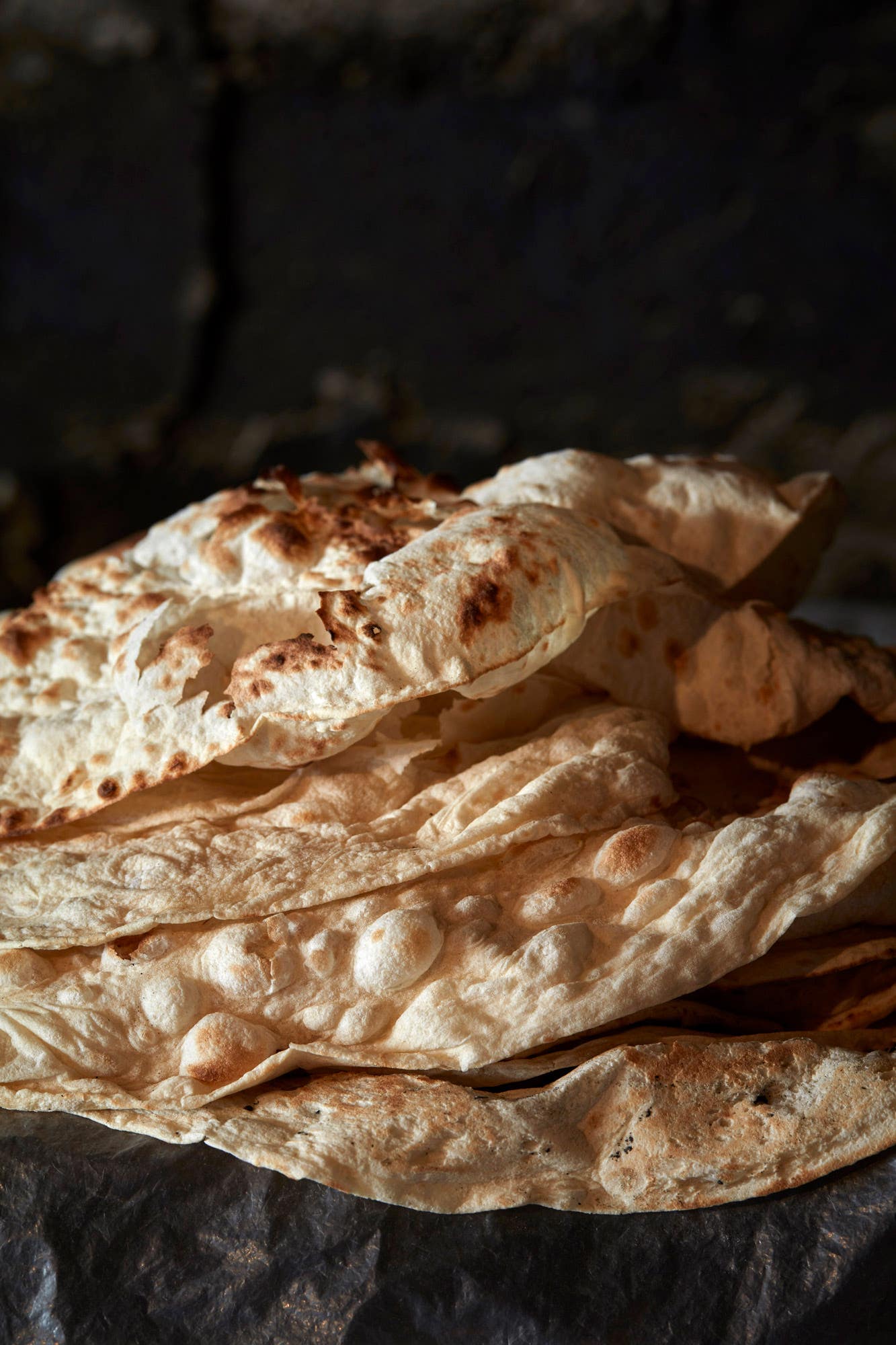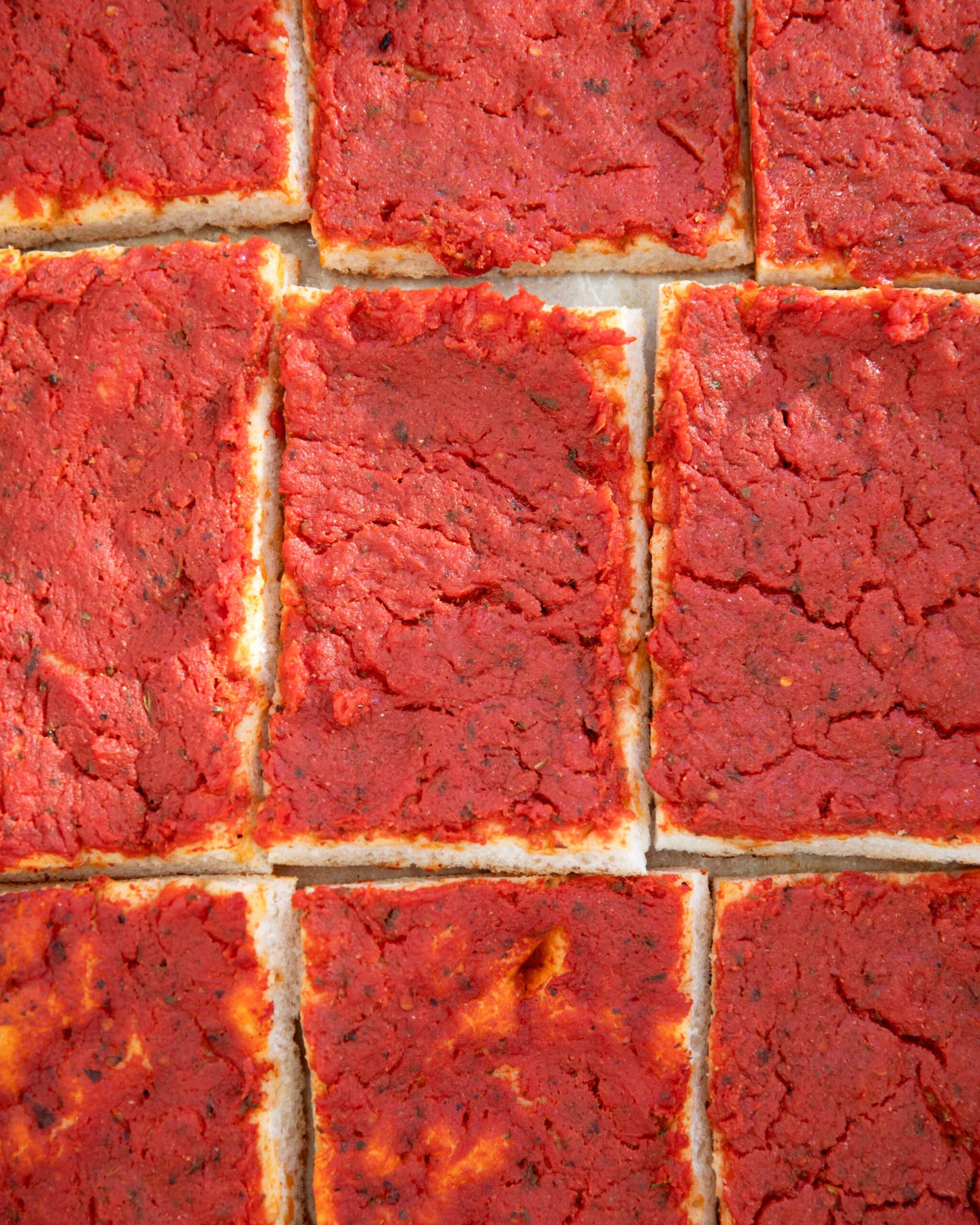
This recipe takes what cookbook authors Kate Leahy and Ara Zada learned from Armenia’s master lavash bakers and adapts it to the realities of a modern home kitchen. Making lavash takes about six hours from beginning to end, so spread the work out over the course of a few days by storing the dough in the refrigerator at the designated intervals. The instructions that follow include options for cooking lavash on a wok, cast iron griddle, or grill. The less time the lavash spends on the heat, the more pliable it will be, and you may have to adjust your heat source at first to cook the dough evenly without burning it. As when making pancakes or crepes, your initial go at it often doesn’t come out well. In Armenia, there’s a saying attributed to the poet Paruyr Sevak: The first lavash baked in the fire is like a first love—too hot to last.
Featured in: Demystifying the Breads of Armenia
Equipment
Ingredients
For the old dough:
- Sunflower or other neutral oil for greasing
- 1⁄2 cup (70 g) all-purpose flour
- 1⁄3 tsp. (1 g) dry instant yeast
For the dough:
- 1 Tbsp. sunflower oil or other neutral oil
- 2 tsp. (7 g) kosher salt
- 3 cups plus 2 Tbsp (440 g) all-purpose flour, plus more for kneading and dusting
Instructions
Step 1
Step 2
Step 3
Step 4
Step 5
Step 6
- Make the old dough: To a medium bowl, add the flour, yeast, and ¼ cup plus 1 tablespoon lukewarm water. Using your hands or a rubber spatula, mix well until the ingredients form a thick paste. Lightly oil a small bowl or container and scrape the paste into it; cover, and set aside at room temperature until nearly doubled in volume and somewhat elastic, 1½—2 hours. (Alternatively, you may refrigerate the old dough overnight and bring to room temperature for at least 2 hours before using.)
- Make the lavash dough: To the bowl of a stand mixer fitted with the paddle attachment, add the old dough, 1 cup lukewarm water, the oil, and salt. Squish the old dough with your hands to break it up in the water (it doesn’t have to be perfectly mixed in.) Add one cup of the flour and mix on low speed until the dough looks like pancake batter. Add the remaining flour and continue mixing on low speed until all of the flour is incorporated into a shaggy dough. Remove the paddle attachment, pulling off any dough stuck to it. If there is dry flour at the base of the bowl, use your hands to press the dough into it. Cover the bowl with a dry kitchen towel and let the dough rest at room temperature for 20 minutes to allow the flour to fully hydrate. (To make by hand, combine the old dough, 1 cup lukewarm water, the oil, and salt in a large bowl and mix together, squishing the old dough into the water with your hands. Stir in the flour gradually with your fingers until a crumbly dough forms, then knead it a few times in the bowl by folding the dough over itself and pressing it down into the bowl. Cover the bowl with a kitchen towel and let the dough rest for 20 minutes.)
- Remove the towel and attach the dough hook to the stand mixer. Mix the dough on medium speed until the dough releases from the sides of the bowl without sticking and feels smooth to the touch, about 4 minutes. (To knead by hand, dust a clean work surface lightly with additional flour and place the dough on top. Begin kneading by stretching and folding the dough over itself until it is smooth to the touch, 5 to 7 minutes.) Lightly oil an 8-cup glass Pyrex measuring cup or a large glass bowl and place the dough inside. Cover the bowl with a plate or plastic wrap and let the dough rest until doubled in volume, about 3 hours. (Alternatively, refrigerate overnight and let the dough come to room temperature for at least two hours before portioning.)
- Portion and shape the dough: Lightly flour a clean work surface and place the dough on top. Using a bench scraper or knife, cut the dough into eight pieces about 3.5 oz [100 g] each. To shape the dough, cup the palm of your hand over one portion at a time and move your hand in a circle. The friction from the counter will help form the dough into a ball. (If there is too much flour on the surface and the dough is sliding around, give the counter a spritz of water and try again.) Lightly oil a large rimmed tray and place the balls of dough on the tray, ensuring that the portions are not touching. Cover with a dry kitchen towel or plastic wrap lightly coated with oil. Set aside at room temperature until puffy, 1–1½ hours, or refrigerate for up to 3 days. (If refrigerating the dough, use plastic wrap to cover it. Let the dough return to room temperature for at least two hours before rolling it out.)
- Lightly dust your work surface and a rolling pin with flour. Pat one of the portions of dough into an oval with your fingertips. Use the rolling pin to sheet the dough out as thinly as possible into a roughly 13- by 9-inch oval. If the dough resists stretching, let it relax and start working on another portion before returning to it. You can also gently stretch the dough with your hands to correct the shape. It doesn’t have to look perfect.
- To griddle the lavash, follow one of the following options: On an overturned wok: Place a carbon-steel wok upside down over a gas burner. Have a pair of tongs handy. Heat the wok over high heat for 1 minute or until a sprinkle of water instantly evaporates. Drape the dough over the wok. Cook for 1 minute or until it has puffed slightly and blistered and you can lift it easily from the wok with the tongs. Turn the dough over to briefly cook the other side, no more than 30 seconds. For extra browning, flip it over for another 30 seconds. Transfer the lavash to a large baking sheet and cover with a dry kitchen towel while you cook the rest of the dough. (In between batches, turn off the burner. The wok heats up quickly, and it will get too hot if the burner is left on.) On a cast-iron griddle: Place a 20-inch cast-iron griddle over two burners. Have a pair of tongs handy. Heat the griddle over medium-high heat for a few minutes or until a sprinkle of water instantly evaporates. Drape the dough over the griddle. Cook for 1 minute or until the dough has puffed slightly and blistered and you can lift it easily with tongs. Turn the dough over to briefly cook the other side, no more than 30 seconds. For extra browning, flip it over for 30 more seconds. Transfer the lavash to a half-sheet pan and cover with a dry kitchen towel while you cook the rest of the dough. (In between batches, keep the griddle turned on, but monitor its heat so it doesn’t get too hot.) On a grill: Have tongs, a pastry brush, a small bowl of vegetable oil, and 2 large baking sheets ready. Coat one of the pans lightly with oil. Heat a gas grill over medium-high heat or prepare a charcoal grill for direct-heat cooking. Ensure that the grill grates are clean. (The grill should be hot enough that you can only hold your hand over the grates for 3–5 seconds.) Place a sheet of dough onto the oiled pan and brush oil over the surface. Drape the oiled dough over the grill. Cover the grill and cook for 25 seconds. Uncover the grill. Using tongs, turn the lavash over and let it cook, uncovered, until evenly blistered and puffed in parts, about 25 seconds more. Transfer to the clean baking sheet and cover with a dry kitchen towel while you cook the rest of the dough. Serve the lavash soon after making it or store it in plastic bags to keep the bread pliable. It’s okay if it dries out and turns brittle; just rehydrate it by misting the lavash with water and covering it with a towel to let it soften again. Soon after, it should be pliable enough to roll up without cracking. If it’s still cracking, mist with more water. NOTE: To turn leftover lavash into crackers, tear or cut the lavash into chip-size pieces and place them in a single layer on a large baking sheet. Brush the pieces with a little oil, sprinkle them with salt, and then toast them in a preheated 400°F oven until golden brown and crispy, about 6 minutes.
Keep Reading
Continue to Next Story










